- Revenue Cycle Management
- COVID-19
- Reimbursement
- Diabetes Awareness Month
- Risk Management
- Patient Retention
- Staffing
- Medical Economics® 100th Anniversary
- Coding and documentation
- Business of Endocrinology
- Telehealth
- Physicians Financial News
- Cybersecurity
- Cardiovascular Clinical Consult
- Locum Tenens, brought to you by LocumLife®
- Weight Management
- Business of Women's Health
- Practice Efficiency
- Finance and Wealth
- EHRs
- Remote Patient Monitoring
- Sponsored Webinars
- Medical Technology
- Billing and collections
- Acute Pain Management
- Exclusive Content
- Value-based Care
- Business of Pediatrics
- Concierge Medicine 2.0 by Castle Connolly Private Health Partners
- Practice Growth
- Concierge Medicine
- Business of Cardiology
- Implementing the Topcon Ocular Telehealth Platform
- Malpractice
- Influenza
- Sexual Health
- Chronic Conditions
- Technology
- Legal and Policy
- Money
- Opinion
- Vaccines
- Practice Management
- Patient Relations
- Careers
Poland: Krakow and the Largest Gothic Church Altar in the World
St. Mary's Church in Krakow, with its magnificent hand carved altar, is not the largest Gothic church in the world. But its magnificent altar and internal beauty make it stand out.
St. Mary’s Church in Krakow, with its magnificent hand carved altar, is not the largest Gothic church in the world; that would be Seville Cathedral. Nor did we claim it was the most famous Gothic church in Europe which probably is Milan Cathedral. And the devoted Catholics of Poland would never, ever, say, of course, it usurped St. Peter’s in Rome as the mother church of the Roman Catholic. But we did say it was the largest Gothic church altar in the world. But it’s not its size that lures us across the main market square in Krakow, the former capital of Poland. Instead, we’re lured the church’s striking beauty. Internal beauty, that is; we have seen more handsome churches elsewhere in Europe.

Krakow’s Church of Our Lady Assumed into Heaven has a lopsided look to it because the two towers surely don’t match and the odd pyramid in glass in front of the church suggests an anachronism as much as the glass house I.M. Pei stuck in front of the Louvre Museum in Paris. In addition, the yellow pavilions giving shade to tourists buying souvenirs in the market square, though welcome, perhaps takes away some of the dignity of a religious institution. But maybe a better attitude for travel writers might be to imagine Freud said, “Sometimes a church (like a cigar) is sometimes just a…church.”

We visited the church twice for photography. The light was different each time but the issue really is: although a wide angle lens can cover the scene, a final size of 490 pixels in width doesn’t achieve clarity when so many persons today are reading text and images on smart phones. The top image attempts to show the high arched dome of the church with gold stars in the blue vault giving those entering a preview of Heaven.
The altarpiece has had its share of misfortune. Before the start of World War II, the Poles dismantled the altar and hid its components all over the country. A Nazi organization — Sonderkommando Paulsen – discovered the hiding places and sent all the pieces to the basement of Nuremberg Castle in Germany. The castle was bombed by the Allies without any damage to the altar. Inside, Polish prisoners of war got word to the Polish Resistance that the altarpiece was there and at the end of the war a Polish tank commander, Count Emeryk Hutten-Czapski, discovered it and returned it to Poland for a 10-year major restoration.
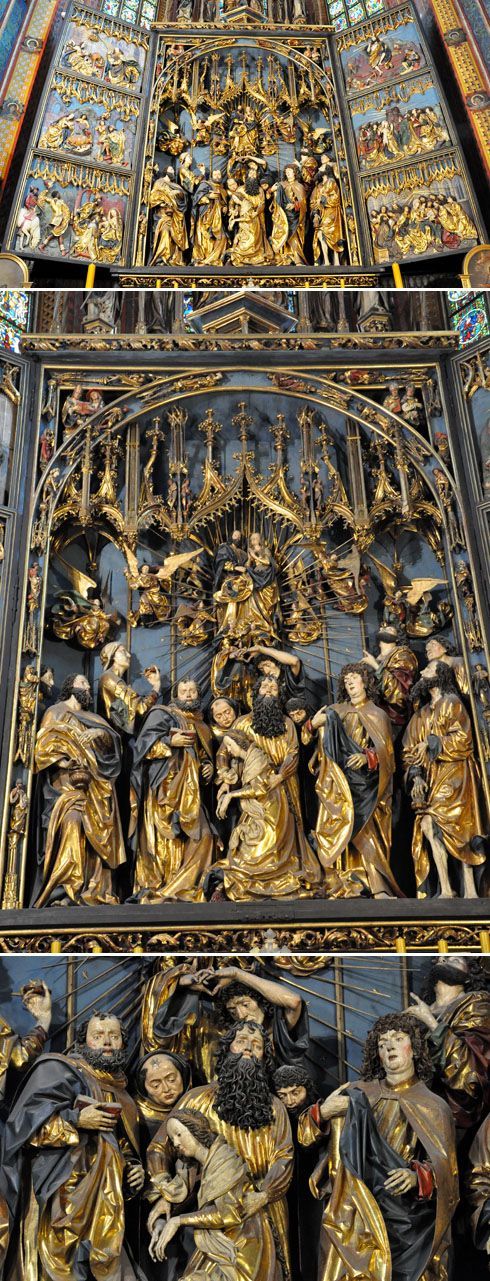
A longer lens shows what Veit Stoss or, in Polish, Wit Stwosz “sacrificed twelve years of his life from 1477 to 1489” to achieve and maybe why, as well. He was showing what Medieval Latin called the quietus, the laying to rest or release and the full title here was the Virgin Mary’s Quietus among the Apostles. As she goes to her rest.
We are Lutheran and Presbyterian — not Catholic – and have been awkward covering the great Catholic cathedrals of Europe. We were more comfortable, in fact, writing 500 years after Martin Luther about traveling to the many German cities connected to him, but there is such a great beauty and impact to the wood carvings in St. Mary’s Church that travelers of any religion might want to post their own photographs online and share the effect with others. Yet there is the saying, “You have to be there,” and the force of the carvings comes from standing there and absorbing them and less so glancing at photographs. (To see the first of several of our 2012 MD Magazine stories about the Martin Luther Trail in Germany click here.)

Scott Lamb, the executive director of the Presbyterian Lay Committee and President of Reformation Press Publishers has this comment about the Veit Stoss altar: “Most of us [who are Protestant] do not believe in the Roman Catholic system of worship with its high altar and emphasis on visual elements...However [to] simply point out the grandeur of the altarpiece itself. … I found myself overwhelmed by the Christology depicted in the panels — so much so that I went back and revisited the basilica later in the week when we had some free time. I prayed and sang hymns quietly to myself as I contemplated the advent, life, work, death, resurrection, and ascension of our Lord Jesus Christ.”
Another more detailed observation about this altar can be found in a university paper in 2008 when David Evans declared Veit Stoss “managed to create in Cracow [sic] one of [the] greatest devotional works of sixteenth-century art which combined the detailed observation of everyday life with ‘broad and deep theological content.’” Evans made this point, too:” The painted or carved altarpiece developed in various forms around Europe following the Lateran Council ruling in 1215 that priests should officiate facing the altar with their backs to the congregation, a decision that stimulated European art more than any other single event.
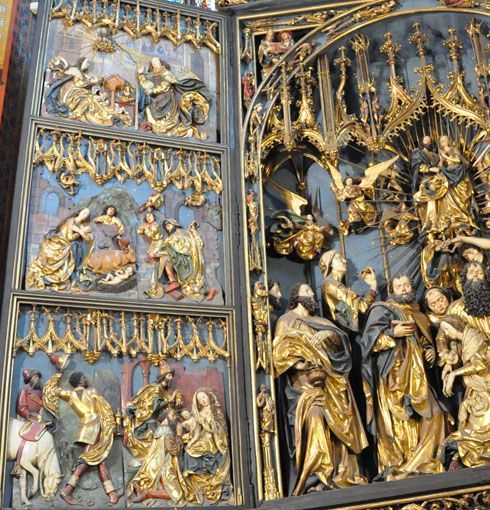
The altar today is kept closed until noon then is left open for the rest of the day. To a degree this has maintained its pristine appearance.
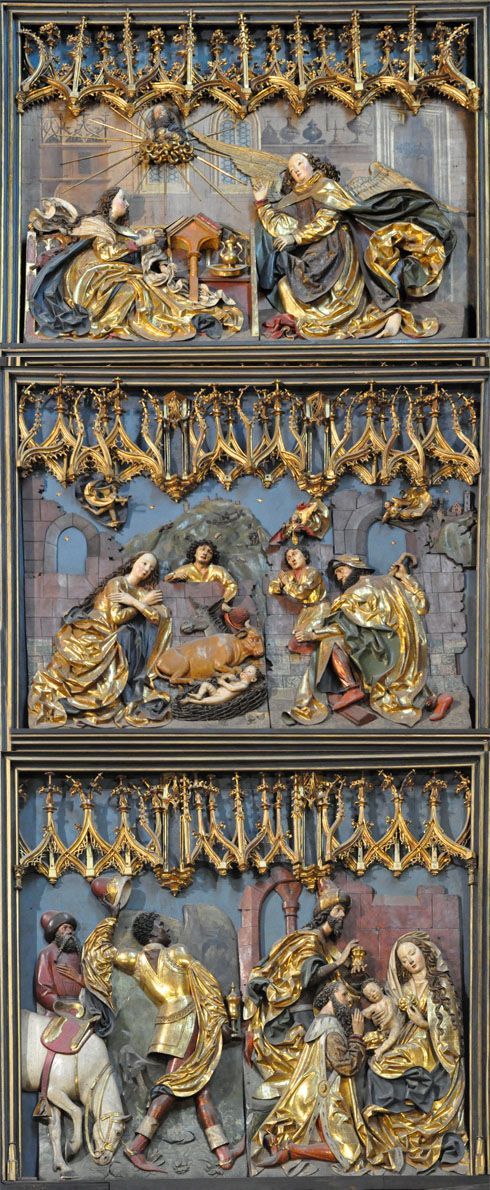
On the left from top to bottom Stoss carved the Annunciation, the Nativity and the Adoration of the Magi.
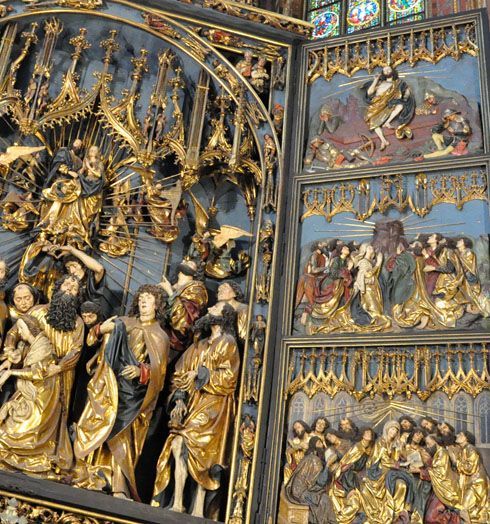
This is the right panel
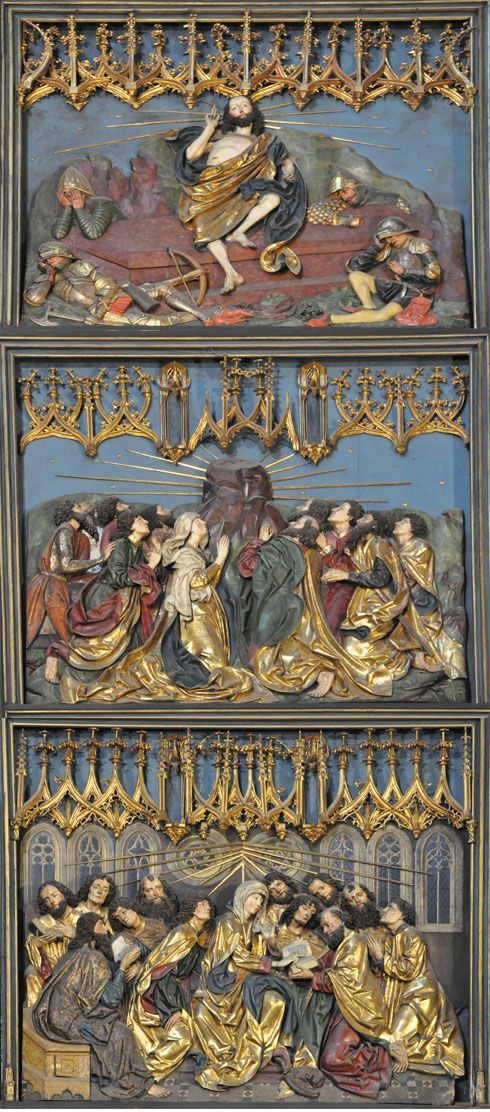
On the right we have from top to bottom the Resurrection, the Ascension and Pentecost.
The altarpiece was carved between 1477 and 1489. It rises 42.65 feet high, and 36 feet wide when the three panels of the triptych are opened. The many figures themselves stand more than 12 feet high.
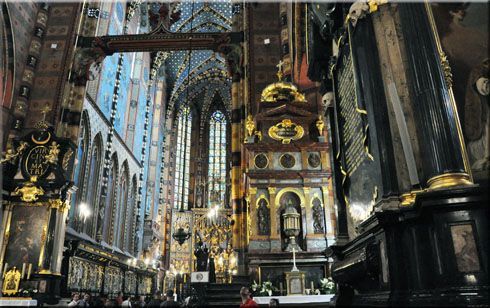
Protestants may not fully understand those events that favor important events in the Virgin Mary’s life but they can appreciate the craftsmanship, the skill and the devotion of this artist, Veit Stoss, who himself had a most complicated life.
Photography by the authors
The Andersons, who live in San Diego, are the resident travel & cruise columnists for Physician's Money Digest. Nancy is a former nursing educator, Eric a retired MD. The one-time president of the New Hampshire Academy of Family Physicians, Eric is the only physician in the Society of American Travel Writers. He has also written five books, the last called The Man Who Cried Orange: Stories from a Doctor's Life.
